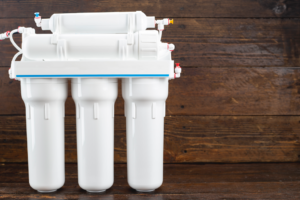
Capable of removing almost all contaminants from water, the reverse osmosis system is affordable to purchase, and it’s also affordable to run. Looking to learn more about reverse osmosis in Burr Ridge? Interested in learning how it works? Then read below!
What is Reverse Osmosis?
Reverse osmosis is a purification process in which water is forced through a semipermeable membrane. As water is pushed through this membrane, the membrane catches all of its contaminants, effectively leaving the water void of all unwanted particles.
This process is powered entirely by water pressure. It involves no electricity whatsoever, thus costing only the price of the water that it needs to operate.
Though reverse osmosis is often used on large scales (particularly in the desalination of ocean water), homeowners know it best for its small-scale, residential applications. When used in homes, reverse osmosis is carried out by a small conditioning system known as — you guessed it — the reverse osmosis system.
Components in a Reverse Osmosis System
We just mentioned the reverse osmosis system, which is the residential purification system that’s used to carry out reverse osmosis on a small scale. Since this is the type of reverse osmosis that homeowners are most likely to encounter, we’re going to discuss its various components below.
Filters
The reverse osmosis system contains three different types of filters: the pre-filters, the membrane filter, and the post-filters.
The pre-filters are used to rid water of large contaminants like dirt and sediment. The membrane filter is used to remove the vast majority of minerals, chemicals, and bacteria that may exist within the water supply. Finally, the post-filter is used to remove any residual contaminants that exist after the water has passed through the membrane filter.
Valves
Reverse osmosis systems make use of a few different valves. These include the line valve, the auto shut-off valve, and the retention valve.
The line valve transfers water from the water supply into the reverse osmosis system. The auto shut-off valve sends purified water into the storage tank; if water levels are too high, it will prevent additional water from coming in. The retention valve keeps purified water in place, preventing it from flowing back into the filters.
Storage Tank
Once water has passed through a reverse osmosis system, it exists in one of two categories: filtered and unfiltered. The former flows into the storage tank, where it sits until it’s ready to be consumed.
Drain
If the filtered water goes into the storage tank, then the unfiltered water goes right down the drain. One thing to note is that the drain sees much more water than the storage tank does, as the vast majority of water that goes through a reverse osmosis system goes unfiltered.
Faucet
The final component on the reverse osmosis system is the faucet. As you can probably guess, the faucet takes water from the storage tank and delivers it to the outside world. And that’s the process — you now have crystal clear purified drinking water to enjoy!
Interested in Utilizing Reverse Osmosis in Burr Ridge?
Are you interested in utilizing a reverse osmosis system? Looking for reverse osmosis in Burr Ridge, specifically? If so, DuPage Water Conditioning has you covered.
We’ve installed reverse osmosis systems in countless homes throughout the Burr Ridge area. Regardless of the size of your water supply, we have you covered.
Contact us today to get the process started!
